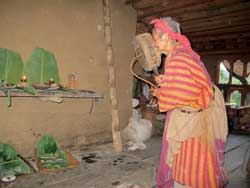The people of Kudra, Phumzur, Jangbi and Wangling who live inside the Jigme Singye Wangchuck National Park, in central Bhutan are called Monpas, believed by some to be the first inhabitants of Bhutan. A close-knit people, they live in one-and two-roomed bamboo walled thatch huts and larger traditional homes.

Although the Monpas are considered to be among the least educated and poorest communities in the kingdom they nevertheless boast a colorful history involving affairs with celestial beings. According to local accounts, these heavenly dakinis and heroes descended from the clouds to father (or mother as the case may be) the first of their people.
A blend of Shamanism and Buddhism sets the tone for Monpa spiritual life while daily livelihood depends largely on the bounty of the forest, resulting in some of the most skilled cane and bamboo work in the kingdom.
The small traditional villages of the Monpa community are scattered on the slope overlooking Mangde Chhu. Hence, the Mangde Chhu valley represents one of the earliest areas of settlement in Bhutan. And because the Monpas practice a mix of animistic shamanism and Buddhism, they are referred to by some as “the people of darkness” given their isolated position in the past. In general parlance Mon refers to people without religion.
Most Monpas still prefer traditional practices to cure sickness. Superstitious and orthodox in nature, the Monpas believe that their cause of sickness is not exactly due to their poor health, sanitation and hygiene but due to evil spirits and bad Karma. But it is encouraging to note that more and more of them are turning to modern medical amenities today.

Today, the Nature Conservation Division is promoting a cane and bamboo project in Jangbi village under their Biodiversity II program. This includes a 10-hectare bamboo plantation which enables Monpa villagers to create handicrafts for sale. The United Nations General Environmental Fund also supports an orchid plantation boasting hundreds of varieties of wild orchid on a one-acre plot managed by the local committee.

